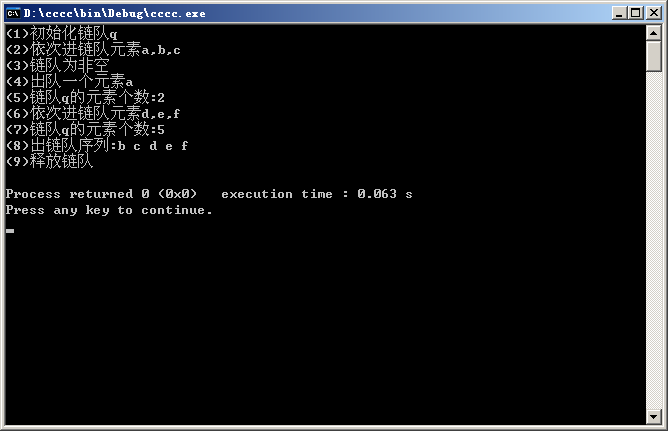/* *Copyright(c)2017, School of computer science, Yantai University *All right reserved. *File name: main.cpp sqqueue.h sqqueue.cpp *Author: Huang Shisheng *Completion date: October 11, 2017 *Version number: v1.0 * *Problem Description: define chain storage structure and implement basic algorithm. *Enter Description: None *Program output: see screenshot of operation result */
This project has been completed with reference to project 1.
Main function:
#include <stdio.h> #include "../liqueue.h" int main() { ElemType e; LiQueue *q; printf("(1)Initialize chain team q\n"); InitQueue(q); printf("(2)Team elements in turn a,b,c\n"); enQueue(q,'a'); enQueue(q,'b'); enQueue(q,'c'); printf("(3)Chain team for%s\n",(QueueEmpty(q)?"empty":"Not empty")); if (deQueue(q,e)==0) printf("Team empty,Can't leave the team.\n"); else printf("(4)One element out of the team%c\n",e); printf("(5)Chain team q Number of elements of:%d\n",QueueLength(q)); printf("(6)Team elements in turn d,e,f\n"); enQueue(q,'d'); enQueue(q,'e'); enQueue(q,'f'); printf("(7)Chain team q Number of elements of:%d\n",QueueLength(q)); printf("(8)Outbound team sequence:"); while (!QueueEmpty(q)) { deQueue(q,e); printf("%c ",e); } printf("\n"); printf("(9)Release chain team\n"); DestroyQueue(q); return 0; }
liqueue.cpp
liqueue.h#include <stdio.h> #include <malloc.h> #include "liqueue.h" void InitQueue(LiQueue *&q) //Initialize chain team { q=(LiQueue *)malloc(sizeof(LiQueue)); q->front=q->rear=NULL; } void DestroyQueue(LiQueue *&q) //Destruction chain { QNode *p=q->front,*r; //p points to the queue header data node if (p!=NULL) //Free data node space { r=p->next; while (r!=NULL) { free(p); p=r; r=p->next; } } free(p); free(q); //Release the space occupied by chain nodes } bool QueueEmpty(LiQueue *q) //Judge whether the chain team is empty { return(q->rear==NULL); } int QueueLength(LiQueue *q) //Return the number of data elements in the queue { int n=0; QNode *p=q->front; while (p!=NULL) { n++; p=p->next; } return(n); } void enQueue(LiQueue *&q,ElemType e) //Join the team { QNode *p; p=(QNode *)malloc(sizeof(QNode)); p->data=e; p->next=NULL; if (q->rear==NULL) //If the chain team is empty, the new node is the team head node and the team tail node q->front=q->rear=p; else { q->rear->next=p; //Chain the * p node to the end of the queue and point the rear at it q->rear=p; } } bool deQueue(LiQueue *&q,ElemType &e) //Team out { QNode *t; if (q->rear==NULL) //Queue is empty return false; t=q->front; //t points to the first data node if (q->front==q->rear) //When there is only one node in the queue q->front=q->rear=NULL; else //When there are multiple nodes in the queue q->front=q->front->next; e=t->data; free(t); return true; }
#ifndef LIQUEUE_H_INCLUDED #define LIQUEUE_H_INCLUDED typedef char ElemType; typedef struct qnode { ElemType data; struct qnode *next; } QNode; //Chain data node type definition typedef struct { QNode *front; QNode *rear; } LiQueue; //Chain team type definition void InitQueue(LiQueue *&q); //Initialize chain team void DestroyQueue(LiQueue *&q); //Destruction chain bool QueueEmpty(LiQueue *q); //Judge whether the chain team is empty int QueueLength(LiQueue *q); //Return the number of data elements in the queue void enQueue(LiQueue *&q,ElemType e); //Join the team bool deQueue(LiQueue *&q,ElemType &e); //Team out #endif // LIQUEUE_H_INCLUDED
The screenshot of the operation is as follows:

Experience after learning:
This project has strengthened my basic ability of building a chain team and gained a lot.
Published 34 original articles·
Zan Zan 9.
10000 visitors+

